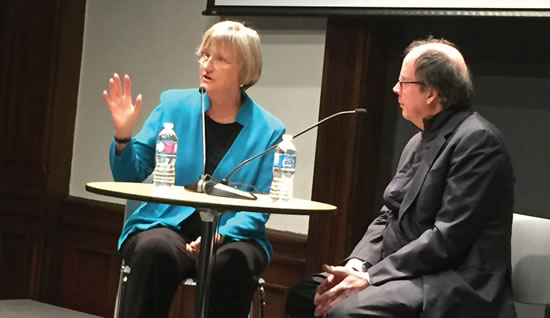WOMEN SHAPING HISTORY 2016
First Woman President of Harvard Re-Examines the Civil War at the Brooklyn Historical Society
By Lydia Liebman

Harvard University President Drew Gilpin Faust & Ric Burns
Recently, Drew Gilpin Faust, the 28th president of Harvard University and the Lincoln Professor of History at Harvard’s Faculty of Arts and Sciences discussed her epic book This Republic of Suffering: Death and The Civil War with Emmy Award-winning documentary filmmaker Ric Burns at the Brooklyn Historical Society. The book, which Burns’ calls “one of the best books about the civil war ever written” explores the impact of the enormous death toll of the Civil War on the lives of 19th century Americans. In 2012, Burns directed Death and the Civil War, an award-wining documentary film for PBS based on Faust’s book.
The evening began with a brief screening of the beginning of Burns’ documentary. In the clip, a dying solider named J.M. Montgomery writes a letter to his father, explaining that he has been mortally wounded in battle and would be notified by friends about the placement of his body. This letter (which was found by Faust at the Confederacy Museum in Richmond) featuring J. M self notifying and writing his own obituary set the stage for the discussion that followed between Burns and Faust. “Whenever I see the opening to the film I am overwhelmed with the magnitude of the tragedy that the civil war was,” said Faust; a sentiment that many in the audience seemed to agree with. She explained that “no one had really explained what it meant to lose such a substantial part of the population” and that in writing her earlier book, Mothers of Invention: Women of the Slaveholding South in the American Civil War, she came across constant discussions of death, prompting her to explore the topic in earnest. According to Faust, 750,000 people died during the American Civil War; the equivalent of 7 million Americans today. “I needed to ask basic questions: how did people mourn? What did they do with the bodies? How did they explain the death toll? What did it mean about the nations state? What does the nation owe to its citizens?” said Faust regarding the questions that brought her to the project.
Faust and Burns spoke at length about the ways the Civil War was unprecedented and highlighted that “scale led to a breakdown in procedure” i.e. the Revolutionary War had only 30,000 men under arms compared to the 3 million under arms in the Civil War. “It wasn’t as if people didn’t care about burying their dead,” she said, “they just couldn’t possibly have been prepared.” Also noted was the disruption in tradition in the sense that 98% of the country at that time considered themselves Christians and had ideals that could be considered ‘Victorian’. “In Victorian culture you die at home surrounded by friends. You show that you are prepared to die and willing to meet your maker. Death was scrutinized so family members could assure that they were going to heaven,” she said, “when people died abroad they couldn’t be offered that closure and the disruption in that relationship is very profound.”
Burns next prompted discussion of the Battle of Gettysburg by asking Faust to give the audience a sense of what that battle was like. She compared it to the Battle of Bull Run, which resulted in 900 deaths. Gettysburg resulted in 7,000 dead and over 50,000 wounded, which was an unprecedented escalation. “So many of these dead are away from home so people started to perform rituals for those that were not family members,” she said, “…soldiers looked desperately for rags to wrap fellow soldiers in… taking care of one another outside of family emerges… OUR dead became the nations dead.” This experience of death led to a series of decisions that led to the notification system and the national cemetery. 17 acres were taken over by government contracts and were designated as a place for reburial of soldiers. This, according to Faust, marked a seismic shift in government policy.
Faust noted the reality of those that lived following the winning of the war and how that population of the 19th century is particularly different than any that came before. “This was a population of people, almost all whom were connected to someone whose fate was unknown,” she said, “…750,000 dead with less than half identified. Think of how that affects a population.” She also spoke about the reburial movement, which ran from 1866 to 1871 and resulted in 74 national cemeteries. The exclusion of Confederate soldiers in this movement resulted in further blistered relations between the North and South and was the impetus for the neo-Confederate cause.
In closing, Faust addressed critics of her book that said it seemed her writing implied that the civil war “should not have happened.” That never occurred to her, she said. “This war cost a lot and we should know that. We shouldn’t hide from that and focus only on the glory and the heroism,” she said. She said that the book has been of particular interest to those in the military because “they know what war costs because they pay that cost.” Historians have a role to play, said Faust: to tell the truth the way it really is and not the delusions that society engages in. #
